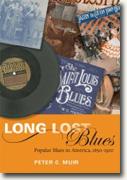Long Lost Blues
Peter C. Muir
book reviews:
· general fiction
· chick lit/romance
· sci-fi/fantasy
· graphic novels
· nonfiction
· audio books
· author interviews
· children's books @
curledupkids.com
· DVD reviews @
curledupdvd.com
newsletter
win books
buy online
links
home
for authors
& publishers
for reviewers

 |
Long Lost Blues: Popular Blues in America, 1850-1920 (Music in American Life) Peter C. Muir University of Illinois Press Hardcover 344 pages January 2010 |
|
In this book, you will learn the difference between popular blues and folk blues, between white blues and black blues, and (my favorite) between allopathic blues and homeopathic blues.
There are, according to Muir, the five necessary elements of the blues: “the twelve bar idiom, blue notes, the four-note chromatic motif, the barbershop ending, and the phrase ‘I Got the Blues.’” You might need to be a musical scholar to understand chromatics or the barbershop ending, but most people associate blues with the 12 bar format, and know without knowing that they know it that slid and curved notes are part and parcel of what makes the blues sound blue. And of course, you know you’ve got the blues when you can come right out and say you got the blues. Allopathic remedies are those in which the cure is the opposite of the malady, and homeopathic remedies are the hair of the dog, remedies that in a small but potent way mirror the disease. Singing the blues is a well-known cure for the blues. How can this be? Yet it’s a musical medicine as old as the hills, harking back to the melancholy songs of the Middle Ages meant to banish care by moaning about it. There’s nothing quite as salutary for a broken heart as singing about dying of one. We tend to think of homeopathic blues as a standard, possibly because much of what we recognize as blues stems from black southern culture where singing one’s sorrow was not only a comfort to the singer, but communicated in cultural code to the audience who shared the same experiences, whether of lost love or being done dirty by those in authority. But Muir asserts that early on, blues was a popular art form as likely to be found in the parlor as in the barroom, and its allopathic side was more prevalent. In our great-grandparents’ day, folks who were afflicted with the blahs were prone to strike up a happy trot with rather bland lyrics to drive off the “blue devils” (Duke fans, take note). With sheet music illustrations, lyrics from a couple hundred classic and less well known blues tunes, and a whole chapter devoted to W.C. Handy, Long Lost Blues And though Muir doesn’t suggest it, it’s not a far reach to imagine that in the mid-twentieth century, the blues “snaked” off in two directions – one is the strain mostly characterized by Southern black males wailing about their personal misfortune, and the other, the strain that resulted in the “high lonesome sound” or bluegrass, generally thought of as the province of Southern white males wailing about their murdered lovers and dead mothers. Both strains are very, very homeopathic. Originally published on Curled Up With A Good Book at www.curledup.com. © Barbara Bamberger Scott, 2010 |
|
|
|
 Click here to learn more about this month's sponsor! |
|
| fiction · sf/f · comic books · nonfiction · audio newsletter · free book contest · buy books online review index · links · · authors & publishers reviewers |
|
| site by ELBO Computing Resources, Inc. | |
